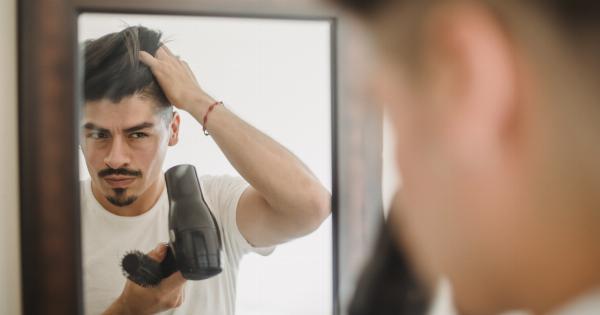Hair loss is a common problem that affects millions of people worldwide. It can be caused by a variety of factors, including genetics, age, stress, and medical conditions.
There are numerous treatments available to combat hair loss, including prescription medications, hair transplant surgery, and topical solutions. However, there is a new revolutionary solution that is gaining popularity among those looking to combat this issue – tweezers.
The Science Behind Hair Loss
Before we delve into the revolutionary solution of tweezers, let’s first understand the reasons behind hair loss. Hair grows from follicles that are located beneath the skin.
Each hair follicle has a life cycle that includes a growth phase, a resting phase, and a shedding phase. During the shedding phase, the old hair falls out, and a new hair replaces it.
However, various factors can disrupt this cycle, leading to hair loss. The most common cause of hair loss is genetics.
Androgenetic alopecia, also known as male or female pattern baldness, is the most common type of hair loss, affecting more than 50% of men and women over the age of 50.
Other causes of hair loss include:.
- Thyroid problems
- Anemia
- Cancer treatments
- Alopecia areata
Traditional Hair Loss Treatments
Traditionally, people have turned to various treatments to combat hair loss. These include prescription medications, hair transplant surgery, and topical solutions.
Prescription medications such as minoxidil and finasteride are used to slow down hair loss and promote hair growth. These medications work by blocking the production of certain hormones that contribute to hair loss.
While these medications can be effective, they can also have side effects such as scalp irritation, itching, and swelling.
Hair transplant surgery is a surgical procedure that involves removing hair follicles from one part of the scalp and transplanting them to the balding area.
The success of this procedure largely depends on the skill of the surgeon and the donor hair’s quality and quantity. Hair transplant surgery is a costly and invasive procedure that requires a significant recovery period.
Topical solutions are also used to combat hair loss. These solutions contain various ingredients such as minoxidil, which is applied directly to the scalp.
These solutions can be effective for some people, but they can also have side effects such as scalp irritation and itching.
The Revolutionary Solution – Tweezers
While traditional hair loss treatments have been around for decades, there is a new revolutionary solution that is gaining popularity – tweezers. Yes, you read that right, tweezers.
Tweezers have been used for decades to remove unwanted hair from the body. However, recently, people have started using tweezers to remove hair from balding or thinning areas on the scalp.
The idea behind this is that plucking out the hair can stimulate the hair follicles, leading to new hair growth.
While this may seem like an unconventional solution, there is some science behind it. Hair follicles contain stem cells that can help regenerate hair.
When a hair is plucked out, the stem cells in the hair follicle may be stimulated, promoting new hair growth.
However, it’s important to note that tweezing should be done carefully and cautiously. Over-plucking can lead to damage to the hair follicle, which can worsen hair loss.
It’s recommended to consult a dermatologist or hair loss specialist before trying this method.
The Benefits of Using Tweezers for Hair Loss
Tweezers offer several benefits for those looking to combat hair loss, including:.
- Cost-effective: Tweezers are an affordable solution compared to prescription medications and hair transplant surgery.
- No side effects: Unlike prescription medications and topical solutions, tweezers do not have any side effects.
- Promotes hair growth: The plucking of hair can stimulate the hair follicles, leading to new hair growth.
- Immediate results: Tweezing can instantly create a fuller look, unlike other treatments that take time to produce results.
The Limitations of Using Tweezers for Hair Loss
While tweezers offer many benefits, there are some limitations to using them for hair loss:.
- May be painful: Plucking hair from the scalp can be painful, especially if done repeatedly.
- May lead to scarring: Over-plucking can lead to scarring and damage to the hair follicle, which can lead to worsening hair loss.
- Not a permanent solution: Hair loss is a progressive condition, and tweezing is not a permanent solution. New hair growth may be temporary.
How to Use Tweezers for Hair Loss
If you’re interested in trying tweezers for hair loss, here are some tips to get started:.
- Consult a hair loss specialist or dermatologist before trying this method.
- Choose a high-quality pair of tweezers that are designed for plucking hair.
- Pluck hairs one at a time to avoid damaging the hair follicle.
- Pluck hairs from areas where there is thinning hair or balding, rather than areas with healthy hair.
- Use a numbing cream or ice pack to reduce pain and discomfort.
- Be patient. New hair growth may take several months to appear.
The Bottom Line
While tweezers may seem like an unconventional solution for hair loss, they offer many benefits. They are cost-effective, promote hair growth, and have no side effects.
However, it’s important to be cautious and consult with a hair loss specialist before trying this method. Tweezers are not a permanent solution, and over-plucking can lead to damage to the hair follicles.
Overall, if you’re looking for an affordable and natural solution for hair loss, tweezers may be worth considering.

























